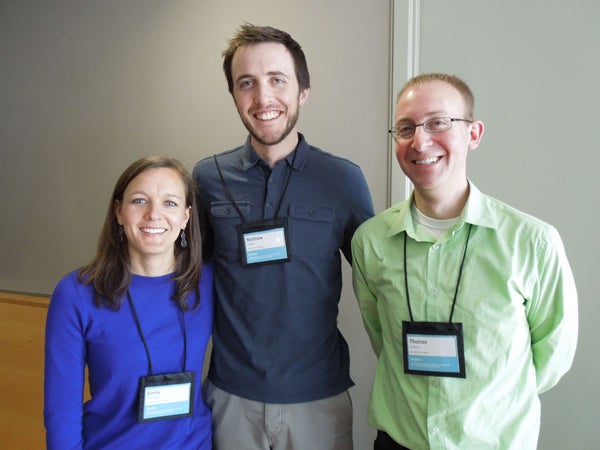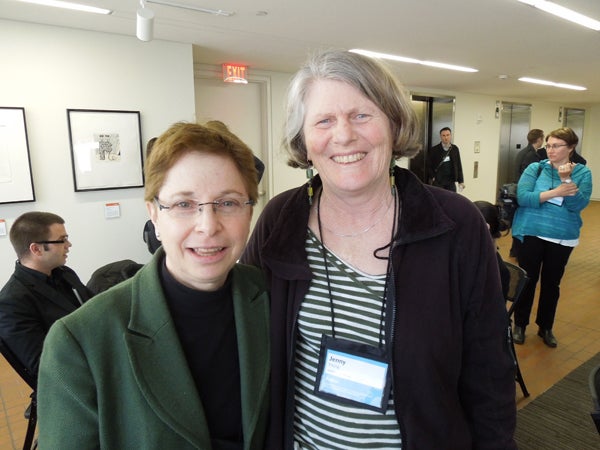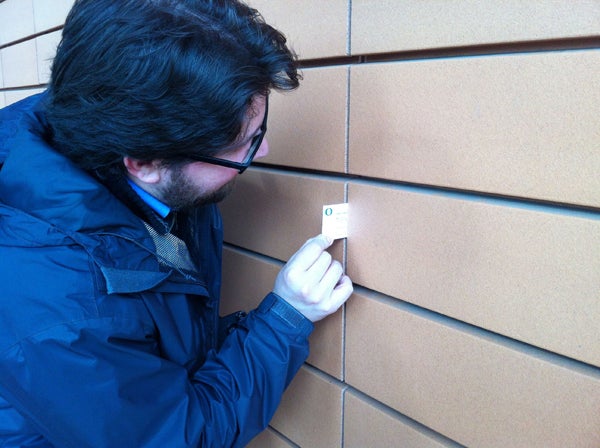Fully ten percent of participants at the 2013 Architectural Research Centers Consortium Spring Conference at the University of North Carolina at Charlotte were A&AA faculty members, current students, or alumni. Given that the theme of the conference was visibility, the UO certainly took the concept to heart.
“The fact that there were 17 Oregon people — faculty, current students, former students — at a conference that had a little over 100 people in attendance made a big impact,” says Professor Howard Davis, who presented a paper at the event.” “It’s of benefit to our school in that it makes our work and research activity visible.”
If that much UO representation wasn’t sufficiently notable, the event — sponsored in March by the Architectural Research Centers Consortium (ARCC) — was organized and moderated by Chris Jarrett, BArch '83, director of the School of Architecture at UNC.

“It was great to have such breadth and depth representation,” says Alison Kwok, professor in the UO Department of Architecture, of the presence at the conference of so many participants directly linked with UO.
The goal of the conference was “to interrogate the idea of visibility from a variety of perspectives, in order to bring research itself into sharper focus." UO-affiliated speakers’ topics ranged from visible ventilation to early childhood education centers. Subject areas in focus at this year’s conference included construction, culture, history, pedagogy, policy, sustainability, and urbanism.
Graduate architecture student Sophia Duluk appreciated that the conference “was not a technical conference, but rather one about the entire spectrum of architecture. Because the net was cast broadly for calls, the papers that I listened to varied widely in content, which made for a far more interesting conference than one only about a niche of architecture,” she says.
Duluk also was inspired by the networking opportunities and the quality of shared information. “I met many people from universities around the country, and came back to UO with many ideas to bring to my studio project from drawing techniques and circulation patterns, to algae producing facades.”

Wesley Thompson, the sole UO undergraduate to attend, says the conference persuaded him that “there is a large disconnect between academia and the profession of architecture. Many of the discussions asked questions about integrating design and research more. (Yet) a very small number of the attendees were practicing architects. What I really took away from the conference is that we need to look at this issue of integrating research into the design process with a greater sense of urgency.”
Davis notes that the UO architecture program connects practice and research (which likely explains why Thompson noted its absence at the conference). “We see theory and research not as isolated and purely ‘academic’ but connected to professional intentions and professional activity,” he says. “Our strengths in theory and in research are connected to our strengths as a design school — grounded, strongly connected to human intentions and ecological issues in the environment, seeing the importance of concrete improvement to the quality of the built world.”
UO’s strength is also in its faculty members and their connections beyond academia.
Just simply going to ARCC would have been great, but going with Alison Kwok was really a treat,” says graduate architecture student Toshi Woudenberg. “Being with Alison, I had the opportunity to spend time with a lot of fascinating people, including Lisa Heschong and Douglas Mahone.”
A&AA’s faculty also helped guide their students through the application and presentation processes. “The process of getting into the conference was quite rigorous,” Woudenberg says. “The abstract was submitted in January to a blind review committee and once that was accepted we had roughly three months to submit the full paper, which was again blind reviewed.” Only about a third of all abstracts submitted for presentation were accepted.

A&AA faculty and student presenters and their topics were:
- Professor Howard Davis, “Making the Marginal Visible: Microenterprise and Urban Space in London” (Davis also moderated an additional session)
- Assistant Professor Mark Donofrio, “Building Knowledge: A Framework for a Translational Research Culture in Architecture”
- Professor Alison Kwok, “Visible Ventilation: A Return to Passive Cooling" and “Passive Aggressive Education: Infusing Passive House Principles into the Curriculum” (Kwok also moderated a session on sustainability)
- Professor Kevin Nute, “Vital: Bringing Buildings and Sustainable Practices to Life”
- Professor Jenny Young and graduate student Anna Liu, “Making Sustainability Visible: Two Early Childhood Education Centers.”
- Graduate student Tom Collins, “Campus Buildings and Student Engagement in Institutional Sustainability Efforts”
- Graduate studenst Sophia Duluk and Toshi Woudenberg, and undergraduate student Wesley Thompson, “Visible Ventilation: A Return to Passive Cooling”
The seven A&AA alumni presenters were:
- Carey Clouse (BArch '05, now assistant professor at the University of Massachusetts), “Researching Architectural Salvage through Experiential Education”
- Diane Fellows (MArch, ‘92, now associate professor at Miami University), “The Moving Image: Research + Design Process”
- Matthew Hogan (MArch, '11, now at Sustainable Design Consulting, LLC), “Passive Aggressive Education: Infusing Passive House Principles into the Curriculum”
- Emily McGlohn (MArch '12, now assistant professor at Mississippi State University), “Lessons from Visualizing the Functions of the Building Enclosure”
- Susannah Nicholson (exchange student from England in the ‘90s), “Biomimetic Performance”
- Aaron Weiss (MArch '10, now at WJE San Francisco), “Vital: Bringing Buildings and Sustainable Practices to Life.”
In addition, three of the most recent UO ARCC Student King Medal for excellence in architectural and environmental design research honorees presented papers. They included Collins (MArch ‘10), Hogan (MArch ‘11), and McGlohn (MArch ‘12).

“It's what we all hope for in academia,” Kwok says of the King Medal winners’ success.
The King Medal is named in honor of the late Jonathan King, cofounder and first president of the ARCC. Selection is based upon criteria that acknowledge innovation, integrity, and scholarship in architectural and/or environmental design research.
“The King Medal is given to the student who has done the best research at each school,” Davis notes, “so within the school (and within the ARCC) it is prestigious and important. It provides a validation of our emphasis on research.”

